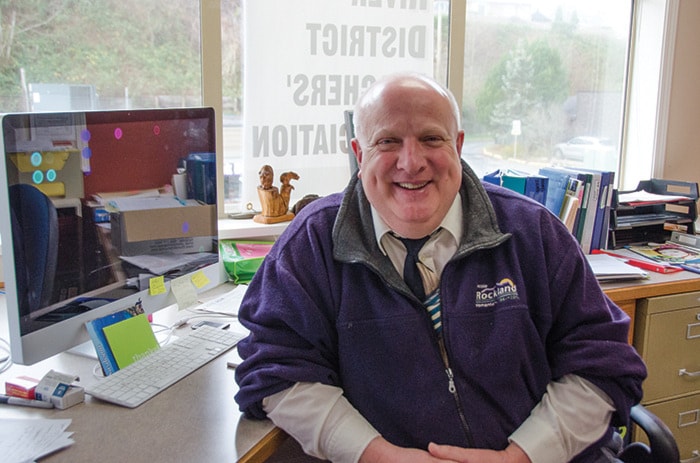The president of the local teachers’ union says students will see improvement in their learning environment possibly as soon as the beginning of February.
The province recently announced that $50 million will be available to fund the hiring of up to 1,100 teachers province-wide during the current school year. That came after the Supreme Court of Canada decided the government would need to reinstate language stripped from contracts with the BC Teachers’ Federation in 2002.
Dave Harper says he has been working with the school district to figure out exactly what that will look like for our district.
“No one wants to reorganize the whole elementary system and all the rest of that kind of stuff, but we can increase all of these part-time teachers that are in these non-enrolling and supporting roles – learning assistant teachers and special education teachers of all sorts who are all working these .2, .4 and .6 shifts. I don’t know how they do it, quite frankly, but we can increase their time for the rest of this year,” Harper says.
District Superintendent Tom Longridge seems to agree.
“The agreement that was announced, in regard to the Supreme Court decision, is going to mean $50 million provincially, and we, as a school district, will be getting a portion of that to enhance learning in our school district through the hiring of a number of a number of new teaching staff. We’re looking forward to doing that and working with the CRDTA (Campbell River and District Teachers Association) and their president in looking at how to do that,” Longridge said at last week’s public meeting of the board of education.
“Given that we are in the middle of the year, it is understood that we’ll be doing that with a minimum of disruption to pre-existing classes and classrooms,” Longridge added. “We want this to be an enhancement and we want to make sure that learning is supported and disruption within classes are minimized, so we’re not looking at reconfiguring the schools or classrooms.”
Longridge said before the specifics were announced that he was estimating there would be money for about 12 new teaching positions within SD72.
When the amount each district would get was announced on Friday, School District 72 (SD72) ended up with just over $524,000 to put into teaching positions, which fits that estimate.
Since the actual amount was announced, Harper and Longridge have been working on how to best integrate it.
“We’ve managed to get on the same page,” Harper says. “We’ve taken care of the middle and secondary schools, but there’s still some tweaking that needs to go on in terms of the elementary stuff.”
What’s been ironed out thus far, Harper says, is that Carihi, Timberline, Phoenix and Southgate – the four schools which house about half of the district’s population – will be getting the equivalent of six additional teaching positions for the rest of this school year.
“It’ll be directed into having the libraries open full time in order to use them as learning commons, and each individual site will have enough full-time equivalent to help where they see fit, essentially. That’s a good thing. That’s a nice big boost at mid year.”
Which leaves money for about another six FTE-worth of teachers to go into the district’s elementary schools, Harper says.
“Those numbers will be spread a bit thinner, obviously, because there are more of those schools, but that’s not to say they won’t have a similar impact, because there are also fewer kids in those schools.”
Harper says the “additional teachers” in all schools will likely be partially made up of new hires and partially in restructured roles for those already in the schools.
“For example, maybe a teacher librarian who is already in place will have their time increased and rather than having two jobs – one where they’re teaching, you know, a humanities class and an English 8 and a leadership class and running the library half-time, they can instead run the library full time and their enrolling classes can be posted as jobs.”
The long and short of it, Harper says, is that students will be getting extra support right when it’s needed.
“I’m quite satisfied how this has played out,” Harper says, adding he is confident they will be able to get the details of who goes where ironed out by the start of the second semester – around Feb. 1.
“It’s almost the perfect time for this to happen,” Harper continues.
“You know, you’ve had your kids in, say, Grade 3, for a few months now, so you really know who those three kids are in your classroom who could really use a boost, and now an additional .2 or .4 comes into your school and is available to really give those kids the boost that they need. This is pretty timely.
“If you throw a half FTE into a middle school or high school mid-year, you can do some serious stuff,” he continues.
“At this time of year, you can really tell who is starting to fall through the cracks. Like, the kids who, if they had a bit more time with one more adult – there’s probably about eight to 10 kids per school who, if you really go after them right now, you can take them a long way.”
But Harper says he’s not going to fully celebrate until he sees what kind of money gets added when the province releases its annual budget next month.
“This was the first hurdle to cross – getting this in place for up until June. It’s great that some of these kids are going to get some extra supports for the rest of this year, but this is the pinch hitting time. We’ll go for the home run when the budget comes down in late February and see how we’re going to move forward.”
